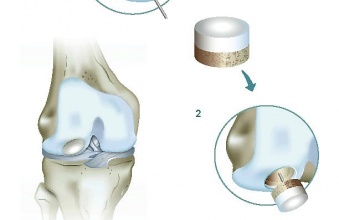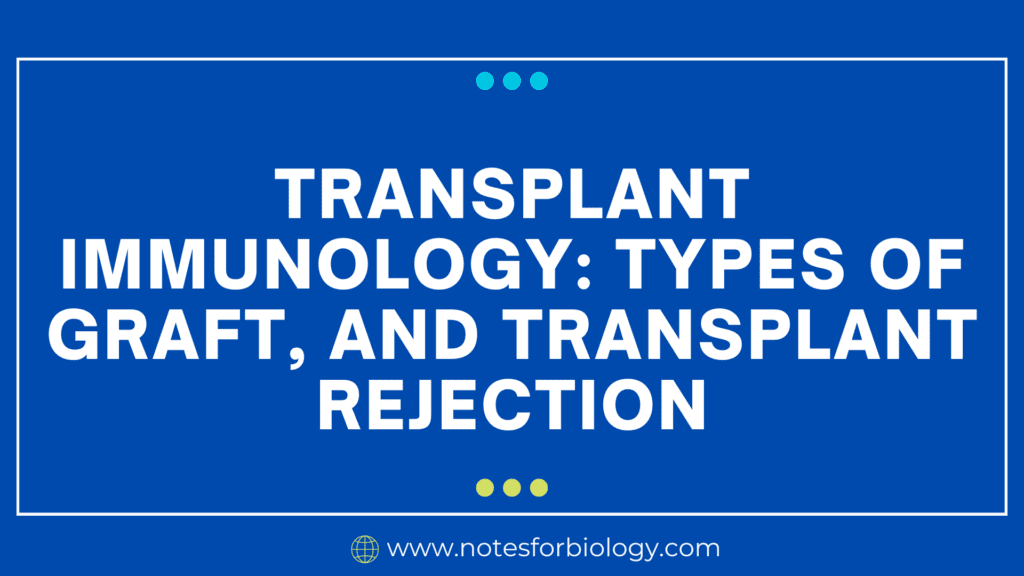What is Transplant immunology?
Transplant immunology is the study of the complex interactions that occur between the immune system and donated organs or tissues is known as transplant immunology. Transplant immunology explores the intriguing realm of immunological reactions in the context of transplantation, both advantageous and harmful. Transplantation, the process of transferring living tissue or organs from one individual to another, offers a lifeline for patients suffering from end-stage organ failure. However, the success of transplantation hinges on overcoming the intricate interplay of the immune system, which naturally perceives foreign tissues as threats. This field of study, known as transplant immunology, explores the complex mechanisms underlying graft acceptance and rejection.
Table of Contents
Types of Grafts
Transplants are broadly classified based on the donor and recipient relationship:
Autograft
This involves transferring tissue from one part of the body to another within the same individual. For example, skin grafts from the thigh to burn wounds. Since the donor and recipient are the same person, there is no chance of immune rejection.
Isograft

This refers to transplantation between genetically identical individuals, such as identical twins. Like autografts, these grafts are not recognized as foreign by the immune system, ensuring high acceptance rates.
Allograft

This is the most common type of transplantation, involving tissue transfer between individuals of the same species but with different genetic makeup. These grafts carry the highest risk of rejection, as the recipient’s immune system recognizes the graft as foreign. Organ transplantation, such as kidney, heart, and liver, falls under this category.
Xenograft
This refers to transplantation of tissue or organs between individuals of different species, such as from pigs to humans. These grafts face significant challenges due to the pronounced genetic differences, leading to strong immune rejection responses and making this approach currently impractical.
Transplant Rejection
The recipient’s immune system plays a crucial role in determining the fate of a transplant. It can either accept the graft as “self” or reject it as “non-self.”
Mechanisms of Transplant Rejection
a) Immune Recognition of Foreign Tissue
The primary challenge in transplantation is the recipient’s immune system recognizing the graft as foreign. This occurs due to the presence of unique proteins called human leukocyte antigens (HLAs), present on the surface of all cells. These HLAs act as “identity markers” and differ between individuals. When a transplant is performed, the recipient’s immune system detects disparities in HLA molecules between the donor and recipient tissues, triggering an immune response.
b) Direct and Indirect Recognition of Graft Antigens
Direct Recognition: This involves the direct interaction of the recipient’s T lymphocytes with donor antigen-presenting cells (APCs), such as dendritic cells. These APCs migrate to the recipient’s lymph nodes, presenting donor antigens to T cells, initiating the immune response.
Indirect Recognition: This occurs when the recipient’s APCs process and present donor antigens to T lymphocytes. Donor antigens are shed from graft cells and taken up by recipient APCs, which then display these antigens to recipient T cells.
c) Immune Responses Leading to Rejection
The recognition of foreign HLA molecules by the recipient’s immune system leads to a cascade of immune responses:
Cell-mediated immunity: T lymphocytes, specifically cytotoxic T lymphocytes (CTLs) and helper T cells (Th1), play a crucial role in graft rejection. CTLs directly destroy graft cells, while Th1 cells release cytokines that further amplify the immune response.
Humoral immunity: B lymphocytes, upon encountering donor antigens, produce antibodies directed against graft cells. These antibodies can damage graft cells directly or activate the complement system, leading to cell lysis.
Types of Transplant Rejection
1. Hyperacute Rejection: This occurs within minutes or hours after transplantation and is the most severe form. It is typically triggered by pre-existing antibodies against the donor’s HLA antigens in the recipient’s circulation. These antibodies bind to graft endothelium, activating the complement cascade, leading to blood vessel damage and organ dysfunction.
2. Acute Rejection: This occurs within days to weeks after transplantation. It is characterized by T cell-mediated inflammation and destruction of the graft. Clinically, this is manifested by signs of organ dysfunction, such as reduced kidney function or increased liver enzymes.
3. Chronic Rejection: This occurs months to years after transplantation and is a slow, progressive process. It is characterized by fibrosis and vascular damage within the graft, leading to gradual organ dysfunction. Chronic rejection is often associated with antibody-mediated mechanisms.
Prevention and Management of Transplant Rejection
1. HLA Matching: Careful matching of HLA antigens between donor and recipient is crucial to minimize rejection risk. Matching HLA types increases the chances of finding compatible donors.
2. Immunosuppressive Therapy: This involves the use of medications that suppress the immune system, preventing it from attacking the graft. These drugs include:
Calcineurin inhibitors: Tacrolimus and cyclosporine
Corticosteroids: Prednisone
Antimetabolites: Azathioprine and mycophenolate mofetil
Anti-proliferative agents: Sirolimus and everolimus
Monoclonal antibodies: Basiliximab, daclizumab, and belatacept
3. Induction Therapy: This involves administering high doses of immunosuppressants immediately after transplantation to prevent initial immune rejection.
4. Tolerance Induction: This is the ultimate goal in transplantation, aiming to achieve long-term graft acceptance without the need for continuous immunosuppression. It involves manipulating the immune system to recognize the graft as “self” and avoid rejection. Various strategies are being investigated, such as using donor-derived cells or immune modulating drugs.
5. Treatment of Rejection: When rejection occurs, prompt treatment is essential. This typically involves increasing the dose of immunosuppressive medication or administering intravenous immunoglobulin. In severe cases, graft removal may be necessary.
Conclusion
Transplantation remains a remarkable medical achievement, offering a second chance at life for individuals with organ failure. However, the complexities of transplant immunology, including the delicate balance between immune suppression and infection risk, continue to pose challenges. Continued research in the field is essential to develop better strategies for preventing rejection, promoting tolerance, and improving the long-term outcomes of transplantation.
Frequently Asked Questions(FAQ)
What do you mean by Transplant immunology ?
Transplant immunology study of the complex interactions that occur between the immune system and donated organs or tissues is known as transplant immunology. Transplant immunology explores the intriguing realm of immunological reactions in the context of transplantation, both advantageous and harmful.
Define HLA Matching?
It is Careful matching of HLA antigens between donor and recipient is crucial to minimize rejection risk. Matching HLA types increases the chances of finding compatible donors.
Related Articles

